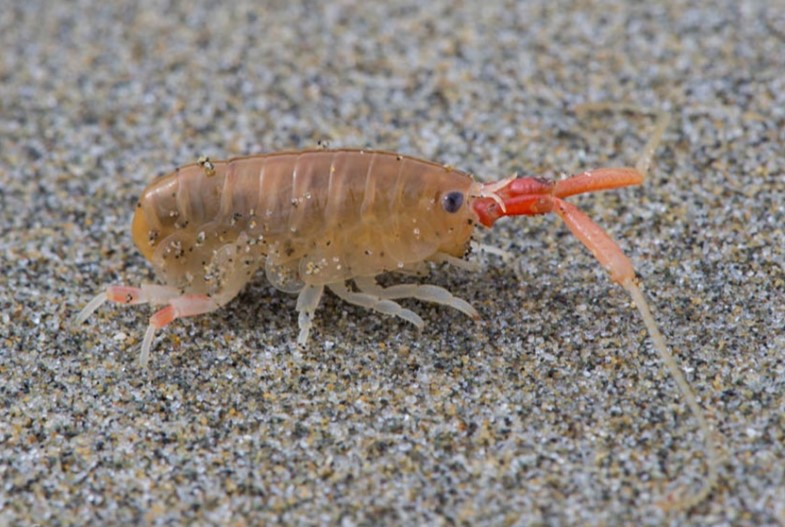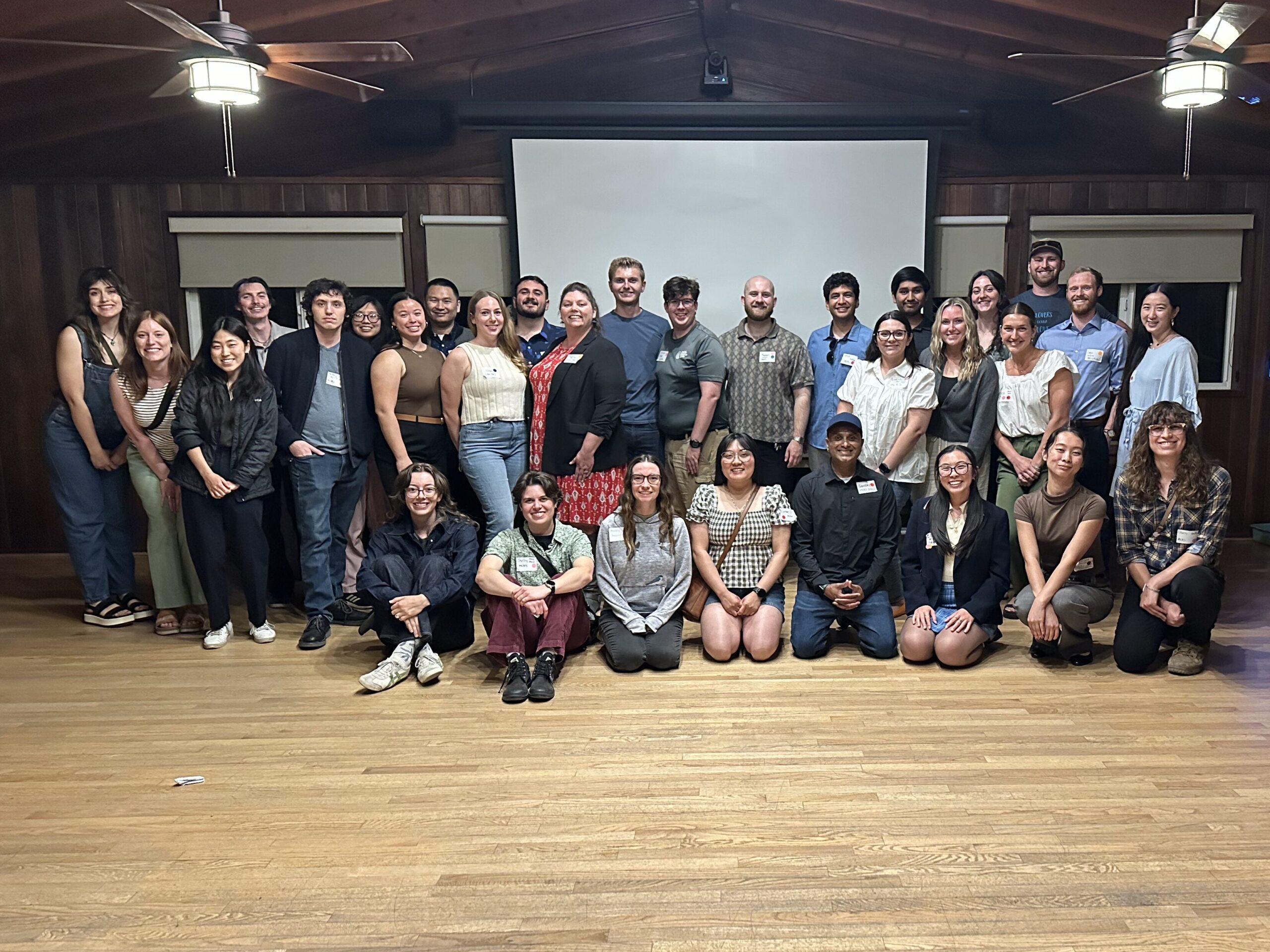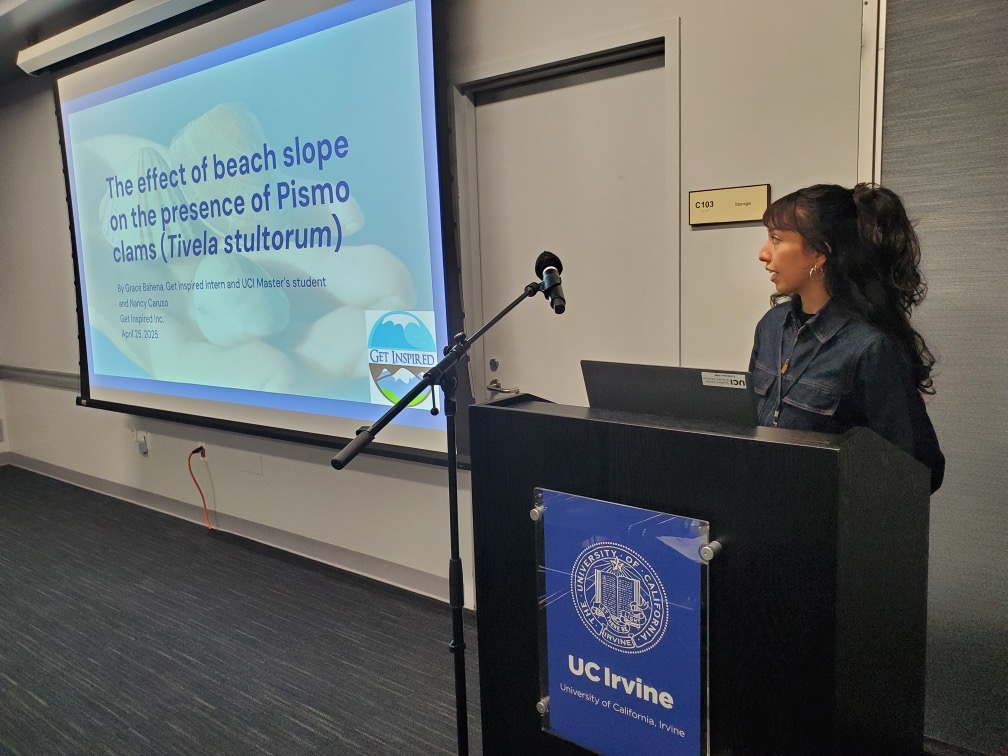Student Blog: Elizabeth Herrmann
Memoirs of a California Beach Hopper
Have you ever felt incredibly small; so invisible that people didn’t even know that you existed? You watch as passerby’s step on you, unnoticed and unappreciated. All the while people gaze at more colorful creatures, the evocative stars in your world. If only they would stop for just a minute to realize the important role you play in your ever-shrinking reality.

Hi, I’m Cal, a crustacean. My full name is Megalorchestia californiana. You would think having “Mega” in my name that I would be something really big, but I’m less than one inch in length. I’m a beach hopper, and I guess I was given this common name by your kind because of my amazing acrobatic skills. I look like a beige land shrimp with big black eyes and long, faint pink L-shaped antennae. Maybe not cute to some, but I do alright for myself. I live my entire life on sandy beaches, burrowing into the sand when I rest and coming out at night to feast on the smorgasbord of algae—known as beach wrack—that the ocean gifts to the shore as the high tide falls. While I feed off the decomposing kelp, birds within the Pacific Flyway pluck me up for a quick snack, and the world keeps on spinning. Evolution did not equip me with much mobility, so traveling long distances is impossible. This is home. Which makes what I am about to tell you all the more difficult…
Generations of hoppers before me used to be found on almost every beach in southern California. We’ve always broken down the kelp that washes ashore, acting as shoreline custodians. We’ve continually served as a food base for migratory and residential birds, as well as a prey base for other predatory terrestrial insects. The beach wrack is our food, our shelter, and the base of our kind’s future existence. In the 1960s this all began to change; beach grooming practices commenced. If you didn’t know, beach grooming is the mechanical removal of beach wrack from sandy shorelines, mostly to make beaches more attractive to you humans. Over 45% of southern California sandy beaches are groomed, which is around over 100 miles (Dugan et. al 2003)! Though this may make the beaches more appealing, this removes my home, crushes fellow beach hoppers and other invertebrates dwelling in the sand, leaves little to no native beach vegetation, destroys eggs laid by grunion, and decreases the biodiversity of shorebirds utilizing the beach (Dugan & Hubbard 2010; Schlacher 2017). This is all because my home is considered an unattractive, smelly, nuisance.
We beach inhabitants understand that grooming removes refuse and plastics that can harm wildlife, but we believe in developing alternative solutions if any beach dweller is going to have a sustainable future. The University of Santa Barbara estimated that more than 4 tons fresh kelp is deposited on a mile of beach per day on a Santa Barbara beach during the summer (Dugan et. al 2003); a hopper could certainly get used to that. However, two-thirds of southern California beaches are devoid of biodiversity largely due to grooming (Schooler et. al 2019). On ungroomed beaches, beach hoppers can reach 100,000 individuals for every meter of beach! But on more desolate beaches, you would be hard-pressed to find any of us. Recently, though, there has been movement in southern California that has given me and my friends hope.
There are places where recreation—people—and biodiversity can coexist. I live in Crystal Cove State Park where management here chooses to leave the beaches in their natural state. During my most recent eavesdropping endeavors, I overheard master’s students talking while surveying my home that other coastal areas may soon follow suit. The goal of these students is to create beach wrack and invertebrates survey protocols to allow for a response to ecological changes over space and time with conservation-driven management decisions. As importantly, the findings from Crystal Cove may provide the information needed to decrease or eliminate grooming practices at other beaches! Schooler et. al (2017) found that local scale impacts to intertidal biodiversity “can be reversed with management changes that reduce disturbance of beaches and allow recovery of sensitive taxa.” This information fills me with optimism and anticipation of a more promising future for the generations that come after me. If you choose not to care about me, please, choose to care about the endangered birds that depend on me. If not them, then choose the declining grunion that lay their eggs in the sand where wrack keeps temperatures cool enough to increase their recruitment. Or perhaps, choose empathy. Remember what it felt like to be small and unimportant in your community. And upon that reflection, I hope you take time to consider mine. Maybe then, you will see me as I really am.

References
Dugan, J.E., Hubbard, D.M., McCrary, M.D., & Pierson, M.O. (2003). The response of macrofauna communities and shorebirds to macrophyte wrack subsidies on exposed sandy beaches of southern California. Estuarine, Coastal and Shelf Science, 58, 25-40.
Dugan, J.E & Hubbard, D.M. (2017). Loss of coastal strand habitat in southern California: the role of beach grooming. Estuaries and Coasts, 33, pp.67–77
Schooler, N.K., Dugan, J.E., & Hubbard, D.M. (2017). Local scale processes drive long-term change in biodiversity of sandy beach ecosystems. Ecology and Evolution DOI: 10.1002/ece3.3064
Schooler, N.K., Dugan, J.E., & Hubbard, D.M. (2019). No lines in the sand: Impacts of intense mechanized maintenance regimes on sandy beach ecosystems span the intertidal zone on urban coasts. Ecological Indicators, 106. ISSN 1470-160X, https://doi.org/10.1016/j.ecolind.2019.105457
Schlacher, T.A., Hutton, B.B., Gilby, B.L., Porch, N., Maguire, G.S., Maslo, B., Connolly, R.M., Olds, A.D., & Weston, M.A. (2017). Algal subsidies enhance invertebrate prey for threatened shorebirds: A novel conservation tool on ocean beaches? Estuarine, Coastal and Shelf Science, 191, 28-38.




